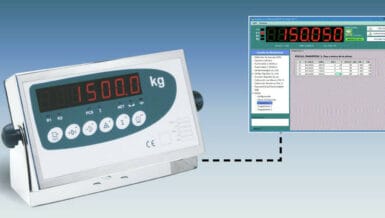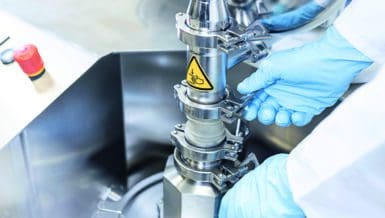During a kick-off meeting, it was discussed which grinding process should be used for preparing API products in a closed system. It was initially decided to grinding all product in one mill. Thereafter, the ground product would be filleddirectly into containers or drums. Once a batch was completed; the system would require cleaning using via a WIP or CIP procedure, permitting changeover to a new product.
As easy as 123…
Two factors have contributed to this solution: Firstly, as previously mentioned, the project required, for safety’s sake, the possibility to enable CIP following completion of a batch. Secondly, due to the requirement of rapid, product changeover process; the customer needed to minimise the time lost during changeover. without any compromise to safety. The CW-150 included a vast selection of sieves, along with providing an infinitely variable regulation of the rotor speed from 400 – 2400 rpm, and using either round or rectangular profiled rotors depending on the product. A single head system would have been too slow during the conversion process. However, two identical systems – both featuring a CW150 grinding head with a drive system – was ascertained to be the ideal solution: saving time during product changeover while maintaining safety.
Two identical grinding systems
A Frewitt mill drive and CIP system were installed on a static column fastened to the production room. The ConiWitt-150’s grinding head could be docked to the FreDrive, which was mounted on a mobile frame as part of the entire grinding system.
This brought the project to the heart of the solution: the grinding system, notably, the mobile part of the plant. The first element of the grinding system consisted of a two-part docking station. The docking process could be carried out either with the mobile vessel by means of the lifting column or using the active valve with automatic feeding. The pins for locking the system were used to centrally align the active and passive valves during the docking process.
The product was fed contamination-free into the inlet vessel, having an observation glass and a level probe to monitor the process and product flow, via the active valve. A magnetic sensor prevented the motor from starting up unintentionally, as long as the feed hopper was not correctly assembled. Downstream of the feed hopper, was the CW150 conical sieve mill that the customer required to grind product batches of max. 300 kg on.
Dry, or moist powder, as well as or granulates could be disagglomerated or ground using sieves with different mesh sizes here. Under the sieve, two probes were installed for measuring the grinding chamber temperature, which would bring the ConiWitt-150 to a stop, in the event a specific temperature value were to be exceeded. The outlet hopper was assembled with a protective grating downstream of the ConiWitt-150. A specifically developed device connected the outlet hopper to the feed hopper to ensure a balanced pressure throughout the grinding system. This led to the last element of the mobile grinding system, specifically, the passive valve. Here, at the end of the process, the filling vessel (drum, container, etc.) was docked here to pick up the ground product.
Consequentially, this mobile grinding system described in detail was ordered in duplicate – and with good reason…
Very carefully considered
The advantage of a twin grinding system was obvious: while one system was in operation, the second could be prepared for a new product with different properties.
Cleaning – name of the game
Each of the twin systems were equipped with eight cleaning nozzles in total. One spray nozzle each was located in the active valve, the feed hopper, the outlet hopper and the passive valve, and while three spray nozzles were located in the conical sieve mill.
High level of flexibility and safety
Vessels (containers, drums) of various shapes and sizes could be connected to the mobile grinding system. A mobile lifting column was used to lift the vessels, transport them to the production site and bring them to the correct height, enabling proper docking.
Flexibility and safety were both ensured throughout the entire system. The grinding chamber was designed for ATEX II 1 D (zone 20), while PTC probes ensured a controlled temperature in critical areas. The components, including vendor parts such as active and passive valves, complying with the ATEX directives.
Conclusion
Nothing ventured, nothing gained. This philosophy has again stood the test of time. Sometimes it’s just a matter of daring to try something that hasn’t been done before. In this situation, the solution was two identical grinding systems. The result was certainly a satisfying one, with unexpected time savings achieved during changeovers, greater flexibility enabled during the process, and a system fulfilling all the safety requirements required in API production.










































